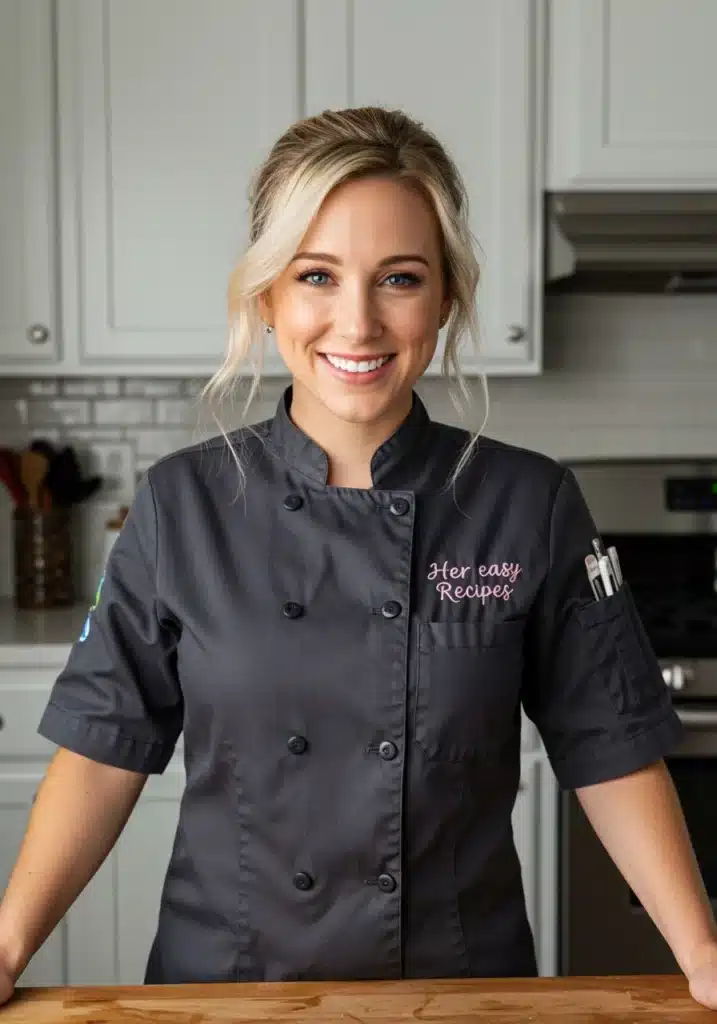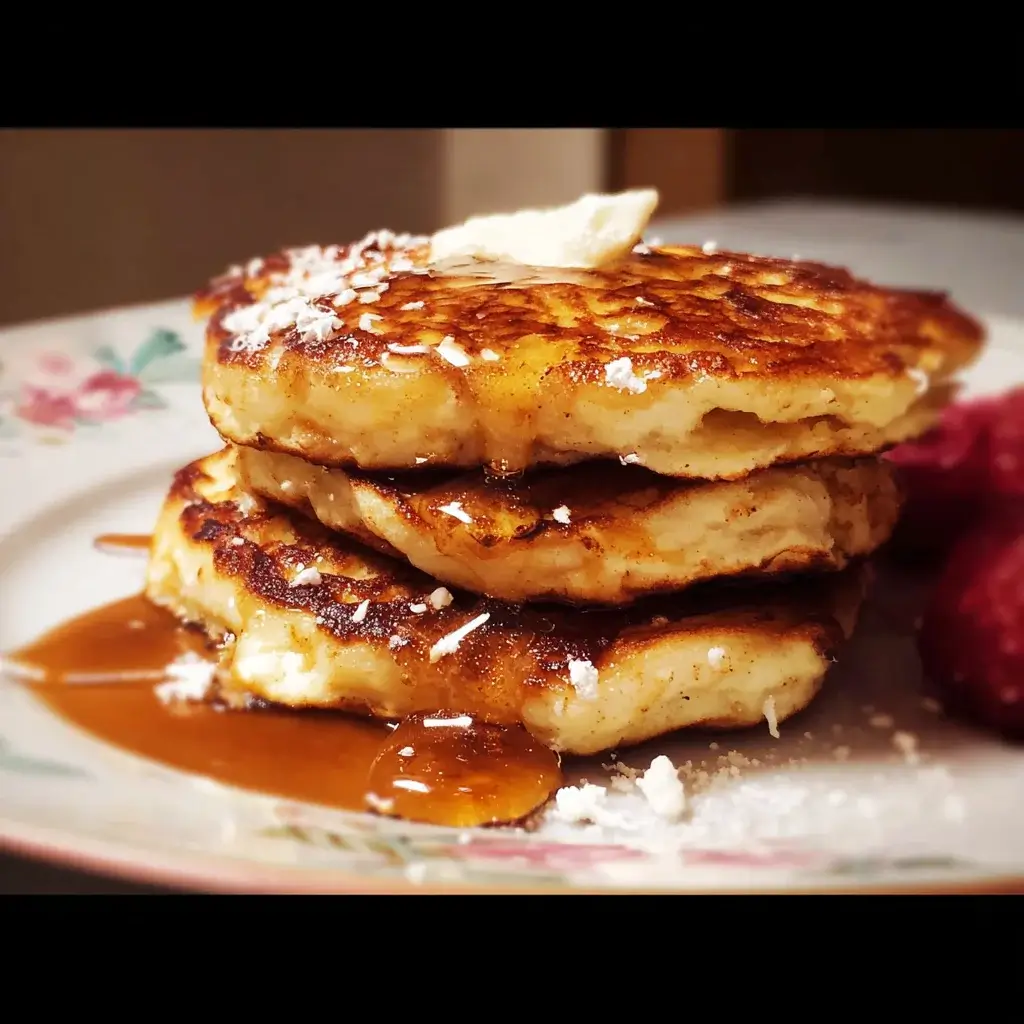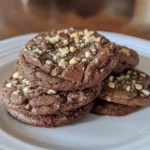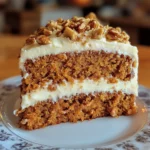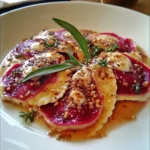I’ll be honest, the first time someone suggested I put cottage cheese in my pancakes, I was skeptical. To me, cottage cheese was something my grandmother ate with canned peaches—healthy, yes, but not exactly an ingredient I associated with a fluffy, decadent weekend breakfast. The recipe sat bookmarked on my computer for months until one Saturday morning when I realized I was low on flour and milk, but had a full tub of cottage cheese in the fridge. With a “what have I got to lose?” shrug, I decided to give it a try. I dumped the ingredients into my blender, whirred it into a surprisingly smooth batter, and ladled it onto a hot griddle. What happened next changed my breakfast game forever. These weren’t the dense, heavy pancakes I was used to. They puffed up beautifully, developing golden, lacy edges. The texture was incredible—light, airy, almost like a soufflé, with a rich, custard-like moistness. The best part? There was no weird cheesy taste. When I served a stack to my family, topped with maple syrup and fresh berries, they were devoured in record time. My kids, who can be notoriously picky, asked for seconds and thirds. Now, these Cottage Cheese Pancakes are our non-negotiable weekend tradition. They’re the recipe I share with every friend who wants to make a healthier breakfast that still feels like a treat. They are, without a doubt, the best pancakes I have ever made.
The Breakfast Revolution: Why Cottage Cheese is the Ultimate Pancake Ingredient
It might sound unconventional, but incorporating cottage cheese into your pancake batter is a culinary masterstroke. It fundamentally transforms the humble pancake from a simple carb-heavy treat into a well-rounded, nutritious, and texturally superior meal. Here’s why these pancakes will become your new gold standard.
A Powerhouse of Protein
The most significant benefit of adding cottage cheese is the incredible protein boost. A standard pancake breakfast can often lead to a quick spike in blood sugar followed by a mid-morning crash. By replacing a good portion of the flour and liquid with protein-rich cottage cheese, you create a pancake that is far more satiating. This high-protein content helps to keep you feeling full and satisfied for hours, making it an ideal breakfast for active individuals, growing children, or anyone looking to start their day with sustained energy rather than a sugar rush. It’s the perfect post-workout meal or a smart way to ensure your kids aren’t asking for a snack thirty minutes after breakfast.
Unbelievably Fluffy and Moist Texture
This is where the magic truly happens. When you blend cottage cheese until it’s completely smooth, you’re not just adding protein; you’re adding a tremendous amount of moisture and a unique structure. Unlike traditional buttermilk or milk, the blended curds create a batter that is light, airy, and almost custardy. The result is a pancake that is incredibly moist on the inside with a delicate, soufflé-like crumb. It’s a far cry from the sometimes dry or gummy texture of flour-heavy pancakes. The cottage cheese ensures each bite is tender and rich, a luxurious texture that feels far more indulgent than its healthy ingredient list would suggest.
Deliciously Versatile and Customizable
These pancakes are a perfect blank canvas for your culinary creativity. The base recipe is simple and delicious on its own, with a subtle tangy flavor similar to what you’d get from buttermilk. But it’s also incredibly easy to adapt.
- Gluten-Free Friendly: Easily swap the all-purpose flour for oat flour, almond flour, or a gluten-free all-purpose blend. The cottage cheese provides so much structure and moisture that these substitutions work beautifully.
- Flavor Boosters: You can add vanilla extract, cinnamon, nutmeg, or lemon zest to the batter to create different flavor profiles.
- Nutrient-Packed Add-Ins: The batter is sturdy enough to support mix-ins like blueberries, chocolate chips, or even finely shredded zucchini or carrots for a hidden veggie boost.
Addresses the #1 Concern: No, They Don’t Taste “Cheesy”
Let’s clear the air on the biggest hesitation people have. When you hear “Cottage Cheese Pancakes,” you might imagine a savory, cheesy flavor. This couldn’t be further from the truth. The key is blending the cottage cheese until it is completely liquid and smooth. When fully incorporated, it loses its distinct “curd” identity and simply lends a rich, slightly tangy background note, much like buttermilk or sour cream would. The primary flavor is that of a classic, delicious pancake, only with a vastly improved texture and nutritional profile.
The Ultimate Cottage Cheese Pancakes: A Complete Recipe
This recipe uses a blender to achieve the smoothest possible batter, which is the key to a perfect, fluffy pancake.
Ingredients
- 1 cup full-fat cottage cheese (4% milkfat): This is the star ingredient. Using full-fat cottage cheese is highly recommended for the richest flavor and the most tender, moist texture. Low-fat versions will work, but the pancakes may be slightly less rich and a bit drier. Small or large curd doesn’t matter, as it will be blended completely.
- 2 large eggs: Eggs provide structure, richness, and leavening. For best results, use room temperature eggs as they will blend more smoothly into the batter.
- ½ cup all-purpose flour: This provides the classic pancake structure. You can substitute this with whole wheat flour (for a nuttier flavor and more fiber) or oat flour for a fantastic gluten-free alternative.
- 2 tablespoons granulated sugar or maple syrup: This adds a touch of sweetness to balance the tang of the cottage cheese. You can adjust this amount to your preference or omit it entirely if you plan on using very sweet toppings.
- 1 teaspoon baking powder: This is the primary leavening agent that helps the pancakes puff up and become light and airy. Make sure your baking powder is fresh for the best lift.
- ½ teaspoon vanilla extract: Adds a wonderful warm, aromatic flavor that complements the other ingredients beautifully.
- ¼ teaspoon kosher salt: Salt is a crucial flavor enhancer; it balances the sweetness and brings out the other flavors in the pancake.
- Butter or neutral oil, for the griddle: For greasing the pan to prevent sticking and to create those delicious, crispy edges.
Step-by-Step Instructions
- Combine Wet Ingredients in Blender: In the jar of a blender, combine the cottage cheese and the eggs. Blend on high for 30-60 seconds, or until the mixture is completely smooth and liquid, with no lumps or curds remaining. This is the most important step for achieving a smooth, non-cheesy texture.
- Add Dry Ingredients and Flavorings: Add the all-purpose flour, sugar (or maple syrup), baking powder, vanilla extract, and salt to the blender with the wet ingredients.
- Blend Briefly to Combine: Place the lid back on the blender and pulse 3-5 times, just until the flour is incorporated. Do not over-blend at this stage. Scrape down the sides of the blender with a spatula and pulse one more time if needed. Over-mixing the batter after the flour has been added can develop the gluten, resulting in tough, gummy pancakes. A few small lumps of flour are perfectly fine.
- Rest the Batter (Optional but Recommended): Let the batter rest in the blender jar for 5-10 minutes. This allows the flour to fully hydrate and the baking powder to start working, which will result in a fluffier pancake.
- Preheat Your Griddle or Pan: Place a large non-stick skillet or a griddle over medium-low heat. Getting the temperature right is key. If the pan is too hot, the outside of the pancakes will burn before the inside is cooked through. If it’s too cool, they won’t brown properly. A good test is to flick a drop of water onto the pan; it should sizzle and dance before evaporating.
- Cook the Pancakes: Add a small pat of butter or a swirl of oil to the hot griddle and let it melt. Pour or ladle the batter onto the griddle to form pancakes of your desired size, about ¼ cup of batter per pancake. Be sure to leave space between them for easy flipping.
- Flip and Finish: Cook for 2-4 minutes on the first side, or until you see bubbles forming on the surface and the edges look set and golden. Carefully flip the pancakes and cook for another 1-2 minutes on the second side, until golden brown and cooked through.
- Serve Immediately: Transfer the cooked pancakes to a plate. You can keep them warm in a 200°F (95°C) oven while you cook the remaining batter. Serve hot with your favorite toppings.
Nutrition Facts
- Servings: Makes about 8-10 (4-inch) pancakes
- Calories per serving (approximate, for 2 pancakes without toppings): 180-220 calories
Disclaimer: The nutritional information provided is an estimate and can vary based on the specific ingredients used (e.g., full-fat vs. low-fat cottage cheese, type of flour).
Preparation Time
- Prep Time: 5 minutes
- Rest Time: 5-10 minutes
- Cook Time: 15-20 minutes
- Total Time: Approximately 25-35 minutes
How to Serve Your Cottage Cheese Pancakes
These protein-packed pancakes are a versatile base for a wide array of toppings, from simple and classic to decadent and dessert-like.
Classic & Simple Toppings
For a timeless breakfast experience that lets the pancake’s flavor shine.
- Pure Maple Syrup: The quintessential pancake topping. A generous drizzle of real maple syrup is always a winner.
- Softened Butter: A pat of butter melting into a warm stack is pure comfort.
- A Dusting of Powdered Sugar: For a simple, elegant finish.
Fresh and Fruity Toppings
To add natural sweetness, vitamins, and beautiful color.
- Fresh Berries: A mix of blueberries, raspberries, strawberries, and blackberries.
- Sliced Bananas: A classic pairing, especially with a drizzle of maple syrup.
- Fruit Compote or Sauce: Gently warm some frozen berries in a saucepan with a splash of water and a little sugar until they break down into a delicious, warm sauce.
- Sautéed Apples: Thinly sliced apples sautéed in butter with a sprinkle of cinnamon until tender.
Decadent & Dessert-Style Toppings
For when you want to turn breakfast into a special occasion.
- Homemade Whipped Cream: Light, airy, and much better than the canned variety.
- A Drizzle of Nutella or Melted Chocolate: For the ultimate indulgence.
- Toasted Nuts: Chopped pecans, walnuts, or sliced almonds for a delightful crunch.
- A Dollop of Yogurt: Plain or Greek yogurt adds extra protein and a tangy contrast.
- A Scoop of Peanut or Almond Butter: For a savory, protein-packed addition.
Perfect Breakfast Pairings
To round out the meal, serve your pancakes alongside:
- Salty Meats: Crispy bacon or savory sausage links provide the perfect salty contrast to the sweet pancakes.
- Eggs: A side of fluffy scrambled eggs or a perfectly fried egg.
- Beverages: A hot cup of coffee, a tall glass of cold milk, or fresh-squeezed orange juice.
Additional Tips for Perfect Pancakes
- The Blender is Your Best Friend: While you can attempt to make these by whisking vigorously by hand, a blender is highly recommended. It’s the only way to completely obliterate the cottage cheese curds, which is essential for achieving the signature smooth, soufflé-like texture and avoiding any hint of “cheesiness.”
- Let the Batter Rest: Don’t skip the 5-10 minute rest period after blending. This simple step allows the gluten in the flour to relax and the starch molecules to absorb the liquid, which results in a thicker batter and a more tender, fluffy final pancake.
- Master the Heat: Low and Slow is the Way to Go: The most common pancake mistake is cooking them on heat that is too high. Because of the high moisture and egg content, these pancakes need to be cooked on medium-low heat. This allows the center to cook through and set properly without the outside burning. Be patient; it’s worth it.
- Don’t Crowd the Pan: Give your pancakes plenty of space on the griddle. Overcrowding the pan lowers its temperature and traps steam, which prevents the pancakes from browning nicely and makes them difficult to flip cleanly. Cook in batches for the best results.
- Make Ahead for Easy Mornings (Freezer-Friendly!): These pancakes freeze beautifully. Cook a full batch and let them cool completely on a wire rack. To freeze, stack them with a small piece of parchment paper between each pancake to prevent sticking. Place the stack in a freezer-safe zip-top bag or container. To reheat, simply pop them in the toaster, toaster oven, or microwave until warm.
Frequently Asked Questions (FAQ)
1. Can I make these pancakes without a blender?
You can try, but the texture will be significantly different. If you don’t have a blender, you’ll need to use an immersion blender or a food processor to get the cottage cheese smooth. If you must use a whisk, press the cottage cheese through a fine-mesh sieve first to break up the curds as much as possible, then whisk it with the eggs until it’s as smooth as you can get it before adding the other ingredients. The pancakes will likely have a more rustic, slightly lumpy texture.
2. Why are my pancakes gummy or dense instead of fluffy?
The most likely culprit is over-mixing the batter after adding the flour. When you over-mix, you over-develop the gluten in the flour, which leads to a tough, dense, and gummy texture. Only pulse the blender a few times—just enough to incorporate the dry ingredients. A lumpy batter (from flour, not cottage cheese) is a good sign!
3. Can I use low-fat or fat-free cottage cheese?
Yes, you can, but it will affect the final result. Full-fat (4% or 5%) cottage cheese provides the best flavor and the richest, most tender texture due to its higher fat content. Low-fat or fat-free versions will still work, but the pancakes may be slightly less moist and flavorful.
4. How do I make these pancakes gluten-free?
These pancakes are wonderfully adaptable for a gluten-free diet. The easiest and most effective substitute for the all-purpose flour is oat flour. You can buy it or make your own by simply blending rolled oats in your blender until they form a fine powder. A 1-to-1 gluten-free all-purpose flour blend will also work well.
5. Can I add protein powder to this recipe for an extra protein boost?
Yes, you can, but with a slight adjustment. You can add 1 scoop of a plain or vanilla-flavored protein powder to the batter. However, protein powder is very absorbent, so you will likely need to add 2-4 tablespoons of milk or water to the batter to thin it back out to the correct consistency. Add the liquid a little at a time until the batter is pourable again.
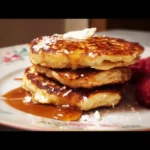
Cottage Cheese Pancakes recipe
Ingredients
-
-
1 cup full-fat cottage cheese (4% milkfat): This is the star ingredient. Using full-fat cottage cheese is highly recommended for the richest flavor and the most tender, moist texture. Low-fat versions will work, but the pancakes may be slightly less rich and a bit drier. Small or large curd doesn’t matter, as it will be blended completely.
-
2 large eggs: Eggs provide structure, richness, and leavening. For best results, use room temperature eggs as they will blend more smoothly into the batter.
-
½ cup all-purpose flour: This provides the classic pancake structure. You can substitute this with whole wheat flour (for a nuttier flavor and more fiber) or oat flour for a fantastic gluten-free alternative.
-
2 tablespoons granulated sugar or maple syrup: This adds a touch of sweetness to balance the tang of the cottage cheese. You can adjust this amount to your preference or omit it entirely if you plan on using very sweet toppings.
-
1 teaspoon baking powder: This is the primary leavening agent that helps the pancakes puff up and become light and airy. Make sure your baking powder is fresh for the best lift.
-
½ teaspoon vanilla extract: Adds a wonderful warm, aromatic flavor that complements the other ingredients beautifully.
-
¼ teaspoon kosher salt: Salt is a crucial flavor enhancer; it balances the sweetness and brings out the other flavors in the pancake.
-
Butter or neutral oil, for the griddle: For greasing the pan to prevent sticking and to create those delicious, crispy edges.
-
Instructions
-
Combine Wet Ingredients in Blender: In the jar of a blender, combine the cottage cheese and the eggs. Blend on high for 30-60 seconds, or until the mixture is completely smooth and liquid, with no lumps or curds remaining. This is the most important step for achieving a smooth, non-cheesy texture.
-
Add Dry Ingredients and Flavorings: Add the all-purpose flour, sugar (or maple syrup), baking powder, vanilla extract, and salt to the blender with the wet ingredients.
-
Blend Briefly to Combine: Place the lid back on the blender and pulse 3-5 times, just until the flour is incorporated. Do not over-blend at this stage. Scrape down the sides of the blender with a spatula and pulse one more time if needed. Over-mixing the batter after the flour has been added can develop the gluten, resulting in tough, gummy pancakes. A few small lumps of flour are perfectly fine.
-
Rest the Batter (Optional but Recommended): Let the batter rest in the blender jar for 5-10 minutes. This allows the flour to fully hydrate and the baking powder to start working, which will result in a fluffier pancake.
-
Preheat Your Griddle or Pan: Place a large non-stick skillet or a griddle over medium-low heat. Getting the temperature right is key. If the pan is too hot, the outside of the pancakes will burn before the inside is cooked through. If it’s too cool, they won’t brown properly. A good test is to flick a drop of water onto the pan; it should sizzle and dance before evaporating.
-
Cook the Pancakes: Add a small pat of butter or a swirl of oil to the hot griddle and let it melt. Pour or ladle the batter onto the griddle to form pancakes of your desired size, about ¼ cup of batter per pancake. Be sure to leave space between them for easy flipping.
-
Flip and Finish: Cook for 2-4 minutes on the first side, or until you see bubbles forming on the surface and the edges look set and golden. Carefully flip the pancakes and cook for another 1-2 minutes on the second side, until golden brown and cooked through.
-
Serve Immediately: Transfer the cooked pancakes to a plate. You can keep them warm in a 200°F (95°C) oven while you cook the remaining batter. Serve hot with your favorite toppings.
Nutrition
- Serving Size: one normal portion
- Calories: 180-220

